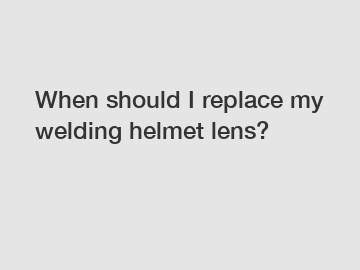When should I replace my welding helmet lens?
Mar. 27, 2024
As a welder, one of the most important pieces of safety equipment you use is your welding helmet. The helmet not only protects your face and eyes from sparks and heat but its lens is also critical in ensuring you have clear visibility while working. Over time, the lens on your welding helmet can become scratched, cracked, or clouded, leading to reduced visibility and potential safety hazards. So, when should you replace your welding helmet lens?
There are several factors to consider when determining if it's time to replace your welding helmet lens. The first and most obvious sign is if the lens is physically damaged. If you notice any cracks, scratches, or pitting on the lens, it's time to replace it. These imperfections can obstruct your vision and make it difficult to see your workpiece clearly. Additionally, damaged lenses can also compromise the integrity of your helmet's protection, putting you at risk of injury.
Another factor to consider is the darkness of the lens. Welding helmets come with lenses of varying shades, ranging from 7 to 13. The darkness of the lens you need depends on the type of welding you're doing and the intensity of the light you're working with. If you find that you're straining to see your workpiece or experiencing eye strain after welding, it may be time to consider replacing your lens with a darker shade. Conversely, if your lens is too dark for the type of welding you're doing, you may also need to replace it with a lighter shade to improve visibility.

It's also important to consider how often you use your welding helmet. If you're a full-time welder who uses your helmet daily, your lens will wear out more quickly than someone who only welds occasionally. Regular use can cause the lens to become dirty and scratched, reducing its effectiveness. If you notice that your lens is difficult to clean or that it no longer provides clear visibility, it's time to replace it.
Additionally, the type of welding you're doing can also impact the lifespan of your helmet lens. Some welding processes generate more heat and sparks than others, which can wear out the lens more quickly. If you're working with high-intensity welding processes such as MIG or TIG welding, you may need to replace your lens more frequently to ensure optimal protection and visibility.
Finally, it's essential to pay attention to the overall condition of your welding helmet. If you notice any cracks or damage to the helmet itself, it's possible that the lens has been compromised as well. Improper storage or handling of your helmet can also lead to damage to the lens. Ensure that you store your helmet in a safe and secure location when not in use to prevent accidental damage.
In conclusion, knowing when to replace your welding helmet lens is crucial for maintaining your safety and the quality of your work. Keep an eye out for physical damage, darkness level, frequency of use, and overall condition of your helmet to determine when it's time for a replacement. By staying proactive and replacing your lens when necessary, you can ensure that you have clear visibility and maximum protection while welding. Your safety is worth the investment in a new lens, so don't hesitate to make the change when needed. Remember, clear vision leads to precise welding!
For more information, please visit Plasma Welding Machine Suppliers, Plasma Arc Welding Machine, Plasma ARC Welding Torch.
72
0
0
Next: None


Comments
All Comments (0)